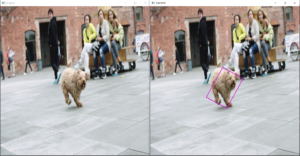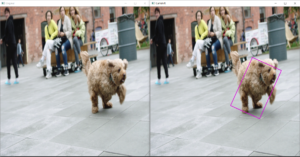使用 OpenCV 使用 Camshift 跟踪对象
OpenCV 是用于计算机视觉、机器学习和图像处理的庞大开源库,现在它在实时操作中发挥着重要作用,这在当今的系统中非常重要。通过使用它,人们可以处理图像和视频以识别物体、面部,甚至是人类的笔迹。
Camshift 或者我们可以说 Continuously Adaptive Meanshift 是 meanshift 算法的增强版本,它为模型提供了更高的准确性和鲁棒性。在 Camshift 算法的帮助下,当跟踪窗口试图收敛时,窗口的大小会不断更新。跟踪是通过使用对象的颜色信息来完成的。此外,它还为对象跟踪提供了最佳拟合跟踪窗口。它首先应用 meanshift,然后将窗口的大小更新为:
![由 QuickLaTeX.com 渲染 \[s = 2\times\sqrt{\frac{M_{00}}{256}}\]](https://mangodoc.oss-cn-beijing.aliyuncs.com/geek8geeks/Track_objects_with_Camshift_using_OpenCV_0.png)
然后它计算最佳拟合椭圆,并再次对新缩放的搜索窗口和前一个窗口应用均值偏移。这个过程一直持续到满足所需的精度。
注意:有关 meanshift 的更多信息,请参阅Python OpenCV:Meanshift
下面是实现。
import numpy as np
import cv2 as cv
# Read the input video
cap = cv.VideoCapture('sample.mp4')
# take first frame of the
# video
ret, frame = cap.read()
# setup initial region of
# tracker
x, y, width, height = 400, 440, 150, 150
track_window = (x, y,
width, height)
# set up the Region of
# Interest for tracking
roi = frame[y:y + height,
x : x + width]
# convert ROI from BGR to
# HSV format
hsv_roi = cv.cvtColor(roi,
cv.COLOR_BGR2HSV)
# perform masking operation
mask = cv.inRange(hsv_roi,
np.array((0., 60., 32.)),
np.array((180., 255., 255)))
roi_hist = cv.calcHist([hsv_roi],
[0], mask,
[180],
[0, 180])
cv.normalize(roi_hist, roi_hist,
0, 255, cv.NORM_MINMAX)
# Setup the termination criteria,
# either 15 iteration or move by
# atleast 2 pt
term_crit = ( cv.TERM_CRITERIA_EPS |
cv.TERM_CRITERIA_COUNT, 15, 2)
while(1):
ret, frame = cap.read()
# Resize the video frames.
frame = cv.resize(frame,
(720, 720),
fx = 0, fy = 0,
interpolation = cv.INTER_CUBIC)
cv.imshow('Original', frame)
# perform thresholding on
# the video frames
ret1, frame1 = cv.threshold(frame,
180, 155,
cv.THRESH_TOZERO_INV)
# convert from BGR to HSV
# format.
hsv = cv.cvtColor(frame1,
cv.COLOR_BGR2HSV)
dst = cv.calcBackProject([hsv],
[0],
roi_hist,
[0, 180], 1)
# apply Camshift to get the
# new location
ret2, track_window = cv.CamShift(dst,
track_window,
term_crit)
# Draw it on image
pts = cv.boxPoints(ret2)
# convert from floating
# to integer
pts = np.int0(pts)
# Draw Tracking window on the
# video frame.
Result = cv.polylines(frame,
[pts],
True,
(0, 255, 255),
2)
cv.imshow('Camshift', Result)
# set ESC key as the
# exit button.
k = cv.waitKey(30) & 0xff
if k == 27:
break
# Release the cap object
cap.release()
# close all opened windows
cv.destroyAllWindows()
输出:


